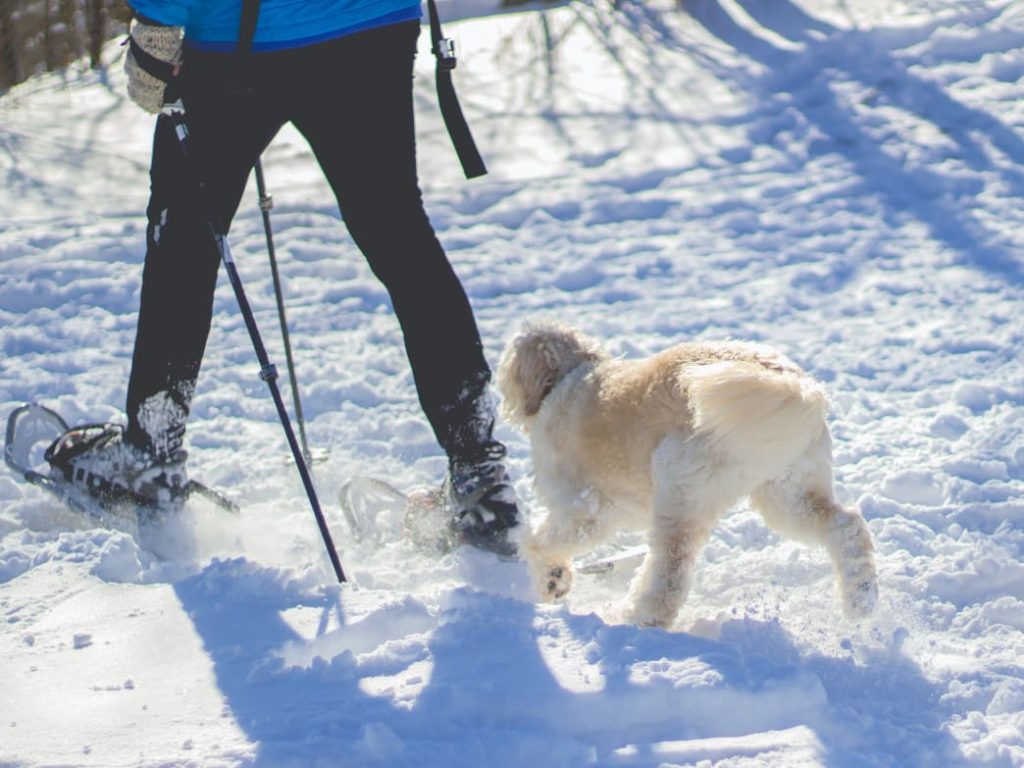When we focus on keeping active we quite often forget that’s also important for us to keep our “furry friends” active in the winter months as well.
This will be a two part series to focus on what is required when we take our pets on our winter activities, regardless of where our travels take us.
One of the best parts of snowshoeing is that it’s a fun activity for the whole family, including pets! Of course, your family can get a good cardio workout and enjoy the winter terrain.
But by including your furry friends, you can watch your pet play in the snow and make the snowshoeing experience even more enjoyable.
To learn more, we sought out an expert pet lover for more info.
Meet Dr. Heather James, veterinarian and medical director at Feltham Animal Hospital and Central Saanich Animal Hospital in Victoria, BC, Canada.
Heather is also a fitness enthusiast and enjoys the outdoors, including snowshoeing in places like Dakota Ridge and Tetrahedron Range in Sechelt, B.C.
Benefits of Snowshoeing With A Pet
Dr. James shares some benefits for bringing your furry friends/family members along on your snowshoeing outings.
James began, “There are many health benefits to snowshoeing with your pet.
Time spent outdoors and with your family (pets included) is good for stress levels.” The outdoors in winter can be an awe-inspiring place.
For dogs, snowshoeing provides the opportunity to experience new smells, new sounds, and unique textures. Even older dogs with sore joints can enjoy the snow with a little extra care. The best cbd for dogs can help to reduce muscle and joint pain, allowing your dog more freedom of movement, even in the cold. A coat and shoes can also help your older dog to feel more comfortable in the snow – you wouldn’t throw an 80-year-old out into the cold without wrapping them up first, so the same applies to older dogs.
With the change in seasons, these sensors change, which is stimulating for pets the snow also provides a new environment for play.
There are fresh animal tracks to smell, a bird call overhead, or a stick to play with submerged in the snow.
For people, mental stimulation can be similar. It’s sensory and we can experience the beauty of nature through sound, smell, sight, and touch.
We hear the running of a stream, smell the scent of pine, see the colors of the sunset, and feel the crunching beneath our snowshoes.
In all, these come together to provide mental health benefits by reducing stress and having fun.

Physical Health Benefits
In addition to the mental health benefits above, there are physical health benefits and snowshoeing is an active sport, and the depth of snow increases the workout.
James says, “The physical exercise will also promote good lean body mass that we know will extend your dog’s healthy lifespan.”
For people, snowshoeing with your pet can help us keep fit too. Pets help motivate us to get out there, despite the weather conditions.
James says, “I always say dogs are our best personal trainers as we have a duty to take them out for exercise and play, something we need for ourselves but often goes by the wayside in lieu of other responsibilities.”
Since snowshoeing is a low-impact activity, people and dogs of all ages and abilities can benefit (with a vet/doctor’s approval).
Companionship
Dogs also can bring people together. As James puts it, “Going snowshoeing with your dog will often lead to invitations for family or friends to go too, so it is a social time. You will likely meet other dog owners out on the trail. Social interaction is important for both us and our dogs. Your dog will be extra tired from the energy used so you’ll have a calm evening to relax”.
However, each dog is different, and it’s essential to know preferred interaction levels too.
If your dog (or you) doesn’t prefer interacting with others on the trail, snowshoeing with your dog still allows time for both of you to bond and have fun together.
In a practical sense, pets as a companion can also be a protector and provide support.
There are some considerations to snowshoeing alone, and pets can be a buffer for that.
In the event of an emergency, having a furry companion with you could end up saving your life.
Tips For Snowshoeing With Pets
James regularly goes snowshoeing with her dog Dottie and shared her tips on how to snowshoe with your pet safely and properly.
Get Your Animal Checked
It is recommended to make sure that your dog doesn’t have any significant medical issues, such as arthritis or dehydration before you go trekking in the snow.
Especially for longer, multi-day trips, you may want to ask your veterinarian if such a big trip is right for your dog.
The other beneficial advice your veterinarian would be able to provide is a list of first aid supplies that you should pack.
Many veterinary clinics sell small pet first aid kits that have things you may need along the way.
Stamina For Snowshoeing
Most dog breeds will do well on a snowshoeing trip, although some shorter-legged dogs may struggle more in the deep soft snow.
You want to make sure your dog’s stamina fits with the duration of your trip.
Remember that the same distance snowshoeing is not the same distance hiking.
Snowshoeing can feel a lot longer than the same trail in summer since snow is harder to walk in and requires more effort.
Larger dogs with good athletic stamina will be great snowshoeing companions.
Part Two will be in next week’s edition – Stay Tuned!!!
The weekly feature is thanks to Christine Blanchette, so feel free to follow her on Twitter








